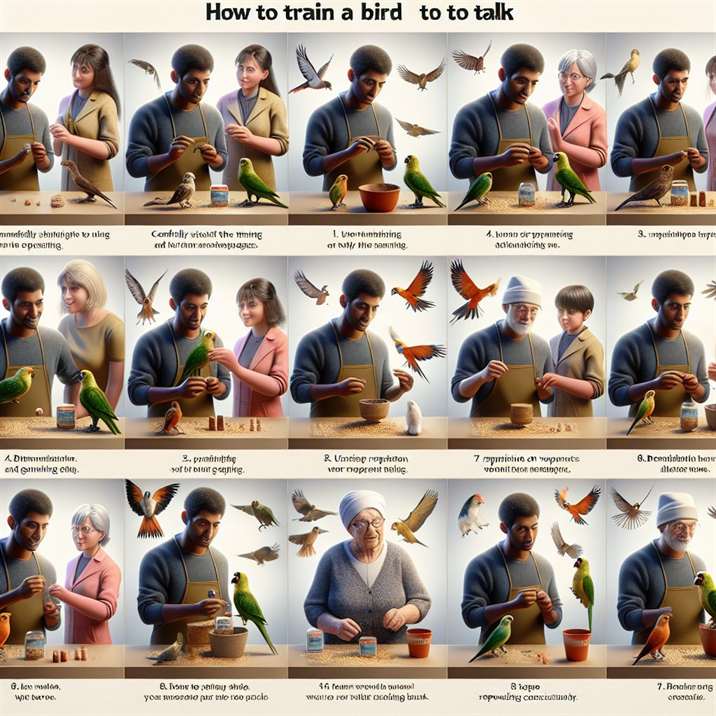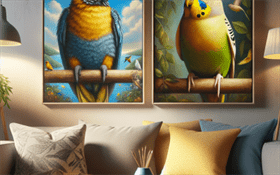How to Train Your Pet Bird to Talk: A Step-by-Step Guide
Introduction
Have you ever marveled at a parrot chatting away or a cockatiel whistling your favorite tune? The ability to how to train a bird to talk is not just a whimsical thought; it’s an engaging journey many bird owners embark upon. In today’s pet-loving world, teaching your feathered friend to mimic sounds and words has become a sought-after skill. With the rise of social media showcasing talking birds, coupled with scientific research highlighting the cognitive abilities of avian species, the interest in this subject has soared.
This comprehensive guide will delve into the fascinating realm of avian communication, offering you insights into the techniques and methods that successful bird trainers use. Whether you’re a seasoned bird owner or a curious beginner, this article will provide valuable tips, tricks, and the science behind how to train a bird to talk.
In this article, you will discover:
- The basics of avian communication
- Effective techniques for teaching your bird to talk
- The importance of patience and consistency in training
- Common pitfalls to avoid during the training process
- Real-life success stories to inspire you
So, why not embark on this delightful journey of how to train a bird to talk? Let’s dive into the specifics!
For more information about caring for your feathered friend, check out our guide on exotic pet care tips.
What is how to train a bird to talk?
Definition
How to train a bird to talk refers to the process of teaching pet birds to mimic human speech or other sounds. This skill is not limited to just parrots; many species, such as cockatiels, mynahs, and even pigeons, can learn to vocalize words and phrases. The training involves consistent interaction, positive reinforcement, and an understanding of the bird’s natural instincts and behaviors.
Historical Context
The art of teaching birds to talk dates back centuries. Historically, birds have been kept as companions, and their ability to mimic human sounds was often seen as a sign of intelligence and charm. The first documented instances of talking birds appeared in ancient cultures, where they were revered for their vocal abilities. Over time, this fascination has led to various training methods evolving, influenced by both behavioral psychology and the unique characteristics of different bird species.
The Importance of how to train a bird to talk
In recent years, the importance of how to train a bird to talk has gained traction, thanks in part to increased awareness of animal cognition. Studies have shown that birds possess advanced communication skills and can understand their environment in complex ways. Training birds to talk not only enriches their lives but also strengthens the bond between pet and owner. Moreover, it offers mental stimulation for the bird, promoting overall well-being.
How to train a bird to talk in the Context of Avian Care
Understanding how to train a bird to talk is essential for responsible pet ownership. It allows owners to engage more fully with their birds, enhancing their emotional health and allowing for a more interactive experience. Just like with any pet, training stimulates the mind and helps mitigate behavioral issues that may arise from boredom or lack of engagement.
Key Players or Contributors
Several organizations and avian behaviorists have contributed significantly to the field of bird training. Notably, the Association of Avian Veterinarians (AAV) promotes the understanding of bird welfare and behavioral enrichment. Furthermore, renowned trainers and authors in the avian community have published countless resources to help owners navigate the intricacies of teaching their birds to talk.
For more insights into avian care and health, you might find our article on common health issues in exotic pets useful.

How Does how to train a bird to talk Work?
The Mechanics of how to train a bird to talk
Training your bird to talk is a systematic process comprising several steps. Here’s how it generally works:
- Choose the Right Environment: Ensure that your bird is in a quiet space free from distractions. A calm environment is crucial for effective learning.
- Select the Right Words: Start with simple words or phrases that are easy to pronounce. Common choices include “hello,” “goodbye,” or the bird’s name.
- Use Repetition: Consistency is key. Repeat the chosen words multiple times during each training session. This helps the bird associate the sounds with their meanings.
- Incorporate Positive Reinforcement: Reward your bird with treats, praise, or affection whenever it attempts to mimic a sound. This creates a positive association with the training process.
- Be Patient: Every bird learns at its own pace. Some may pick up words quickly, while others may take weeks or even months. Patience is crucial.
- Practice Regularly: Short, frequent training sessions are more effective than long, infrequent ones. Aim for 5-10 minutes a few times a day.
Technological Foundations of how to train a bird to talk
In recent years, technology has played a role in enhancing avian training. Various devices, such as sound recorders and specialized training apps, can help bird owners introduce new words and sounds. These tools can be especially useful for busy owners who may not have time for regular training sessions.
Real-World Applications of how to train a bird to talk
Birds that are taught to talk can become more interactive companions. For example, many owners report that their trained birds become more engaged during social interactions, often mimicking greetings or responding to questions. Talking birds can also serve as a source of entertainment, bringing joy to both the owner and their guests.
Case Studies/Examples of how to train a bird to talk in Action
- Coco the Cockatoo: Coco learned over 50 words and phrases within a year of consistent training. Her owner used a combination of verbal repetition and rewards, making Coco a delightful conversationalist.
- Polly the Parrot: After being adopted from a shelter, Polly’s new owner dedicated time each day for training sessions. Within months, Polly was not only mimicking words but also responding to questions, showcasing her understanding of language.
For a broader understanding of pet care, you can explore our exotic pet grooming guide.
Effective Techniques for how to train a bird to talk
Start with the Basics
When initiating the training process, it’s essential to keep things simple. Focus on basic commands and phrases that your bird can easily replicate. Here are a few techniques to consider:
- Use Clear Enunciation: Speak clearly and slowly when introducing new words. Birds can pick up on the nuances of sound, so clarity is essential.
- Engage with Your Bird: Make eye contact and use an enthusiastic tone. Birds are social creatures, and engaging them in this way can motivate them to respond.
Create a Routine
Birds thrive on routine. Establishing a regular training schedule helps them anticipate learning times, which can enhance their willingness to participate. Here’s how to create an effective routine:
- Set Specific Times: Train your bird at the same times each day to build familiarity.
- Limit Distractions: Turn off the TV or move to a quieter space to minimize disturbances.
- Keep Sessions Short: Aim for short bursts of training (5-10 minutes) to keep your bird focused.
Incorporate Games
Training doesn’t have to be a monotonous task. Incorporating games can make learning fun for both you and your bird. Here are a few ideas:
- Sound Mimicry Game: Play sounds or phrases and encourage your bird to mimic them. Reward them with treats when they succeed.
- Interactive Toys: Use toys that make sounds or mimic words. As your bird interacts with them, it may inspire vocalization.
Common Pitfalls to Avoid During how to train a bird to talk
Overlooking the Bird’s Mood
Birds, like humans, have good and bad days. If your bird seems disinterested or agitated, it’s best to skip the training for that day. Pushing your bird when it’s not in the mood can lead to frustration for both parties.
Using Negative Reinforcement
Avoid using negative reinforcement, as it can harm the trust between you and your bird. Instead, focus on positive reinforcement to encourage vocalization and maintain a happy training environment.
Setting Unrealistic Expectations
Not every bird will become a chatterbox. Factors such as species, personality, and individual willingness to learn play significant roles in a bird’s ability to talk. Setting achievable goals will help maintain motivation and satisfaction throughout the training process.
Conclusion
Teaching your bird to talk can be a gratifying experience that deepens the bond between you and your feathered friend. By understanding how to train a bird to talk, utilizing effective techniques, and avoiding common pitfalls, you can create a positive and engaging training environment. Remember to be patient and consistent, celebrating small victories along the way.
Resource Links:
- thesprucepets.com: … Want to teach your parrot or other pet birds how to talk? Use these step-by-step instructions to get your bird chatting away.
- petmd.com: … Say it repeatedly to the bird throughout the day, using the same tone and inflection each time, and pair it with a reward. “Birds will pay …
- trainedparrot.com: … The parrot should now step up onto the perch. You can close the cage door and talk to the parrot for a little while but then be sure to give …




0 Comments